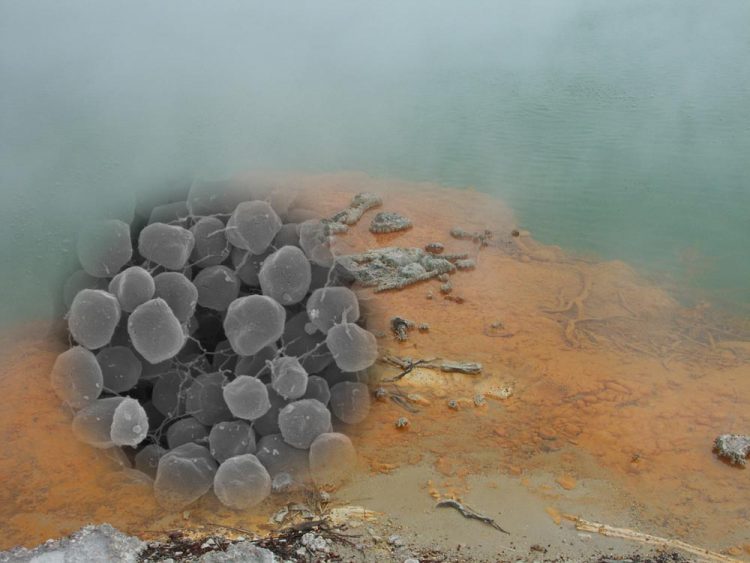Project on microorganisms: Saci, the bio-factory

The montage shows the Champagne Pool (Waiotapu geothermal area, New Zealand) and - in the round picture - a collection of Saci cells as they occur there. Photo: UDE/Siebers
Yeast and bacteria such as Escherichia coli and Bacillus subtilis are among the most widely used microorganisms in industry. Their properties are transferred or modified so that they transform substrates into value-added products or produce enzymes.
However, their range of application is limited: yeast and bacteria cannot survive in high temperatures or low pH, i.e. acidic environments.
Archaea could serve as a promising alternative. ‘Many of these unicellular organisms can adapt to extreme habitats. They possess unique metabolic traits and robust enzymes’, Professor Bettina Siebers explains, ‘and yet their great biotechnological potential has been neglected so far. We would like to change this with our project.’
Professor Siebers is an expert in molecular enzyme technology and biochemistry and coordinates the ‘HotAcidFACTORY’ project supported by her UDE colleagues Markus Kaiser (Biological Chemistry) and Oliver Schmitz (Applied Analytical Chemistry). Researchers of the Universities of Freiburg and Bielefeld and TU Wien are also involved in the project.
The team wants to establish Sulfolobus acidocaldarius, or in short: Saci, as a bio-factory. This organism is a member of the Archaea with optimal growth at temperatures between 75 and 80 °C and a pH between 2 and 3, which is similar to lemon juice. It is not pathogenic and thus does not entail any health risks. Saci is found naturally in acidic hot springs in the Azores or Iceland, for example.
In their laboratories, the scientists aim to design Saci so that it can process industrial waste and transform it into new products such as bio-acids or bio-alcohols. ‘We want to modify Saci to enable CO2 fixation. Thus, the greenhouse gas released during numerous industrial processes is integrated into its metabolism’, Bettina Siebers continues, ‘alternatively, it can be made to live and feed on glycerol. This plant-based waste product is formed during the production of bio-fuels and is of interest for various applications.’
*HotAcidFACTORY (Sulfolobus acidocaldarius as a new thermoacidophile biological factory) is a three-year project, which is funded by the ‘Microbial factories for industrial bioeconomy—new platform organisms for innovative products and sustainable bioprocesses’ (Mikrobielle Biofabriken für die industrielle Bioökonomie – Neuartige Plattformorganismen für innovative Produkte und nachhaltige Bioprozesse) programme of the Federal Ministry of Education and Research. The UDE will receive 1.4 million of the total funding of 2.2 million euros.
Note for the editors:
A photomontage (Photo: UDE/Siebers) is available under the following link:
https://www.uni-due.de/de/presse/pi_fotos.php
The montage shows the Champagne Pool (Waiotapu geothermal area, New Zealand) and – in the round picture – a collection of Saci cells as they occur there.
Editor: Ulrike Bohnsack, phone 0203/37 9-2429, ulrike.bohnsack@uni-due.de
Translator: Carmela Welge, carmela.welge@uni-due.de
Prof. Dr. Bettina Siebers, Molecular Enzyme Technology and Biochemistry, phone: 0201/18 3-7061, bettina.siebers@uni-due.de
Media Contact
All latest news from the category: Life Sciences and Chemistry
Articles and reports from the Life Sciences and chemistry area deal with applied and basic research into modern biology, chemistry and human medicine.
Valuable information can be found on a range of life sciences fields including bacteriology, biochemistry, bionics, bioinformatics, biophysics, biotechnology, genetics, geobotany, human biology, marine biology, microbiology, molecular biology, cellular biology, zoology, bioinorganic chemistry, microchemistry and environmental chemistry.
Newest articles

Microscopic basis of a new form of quantum magnetism
Not all magnets are the same. When we think of magnetism, we often think of magnets that stick to a refrigerator’s door. For these types of magnets, the electronic interactions…

An epigenome editing toolkit to dissect the mechanisms of gene regulation
A study from the Hackett group at EMBL Rome led to the development of a powerful epigenetic editing technology, which unlocks the ability to precisely program chromatin modifications. Understanding how…

NASA selects UF mission to better track the Earth’s water and ice
NASA has selected a team of University of Florida aerospace engineers to pursue a groundbreaking $12 million mission aimed at improving the way we track changes in Earth’s structures, such…





















